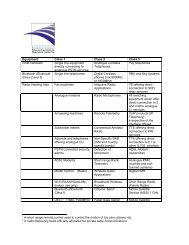Lebanese National Frequency Allocation Table LNFT
Lebanese National Frequency Allocation Table LNFT
Lebanese National Frequency Allocation Table LNFT
- No tags were found...
You also want an ePaper? Increase the reach of your titles
YUMPU automatically turns print PDFs into web optimized ePapers that Google loves.
General Overview<strong>Lebanese</strong> <strong>National</strong> <strong>Frequency</strong> <strong>Allocation</strong> <strong>Table</strong><strong>LNFT</strong>SUMMARYThe <strong>LNFT</strong> allocates Lebanon’s radiofrequency spectrum into a number of frequency bands relevant toITU regulations and specifies the general purposes for which the bands may be used. This process isreferred to as the allocation of frequency bands to radiocommunication services.The primary objectives to be achieved with the radio spectrum are:- To harmonize spectrum use with international developments. In this regard, Lebanon followsclosely the work of the ITU, the CEPT, the league of Arab States and the local regionalorganization- To manage the radio spectrum within Lebanon taking into account the governmentalrequirements and the needs of the various commercial sectors- To stimulate technological innovation and competitivenessThe <strong>LNFT</strong> will be updated from time to time dependant on international initiatives and nationaldecisions. The main source documentation used in the development of this version of <strong>LNFT</strong> was the ITURadio Regulations and the Provisional Final Acts of the ITU WRC07.<strong>LNFT</strong> DetailsCategories of services: each band may be allocated to one or more services. The services printed incapitals are called “primary” services; the names which printed in small characters are called“secondary” services. Stations of a secondary service shall not cause harmful interference to stations ofprimary service and cannot claim protection from harmful interference from stations of a primaryservice.Construction of the <strong>Table</strong>:The <strong>Table</strong> is divided into 6 columns.Column1: indicates the frequency band in kHz, MHz and GHz.Column2: contains details of the allocations to radiocommunication services within the ITU RadioRegulations RR for Region 1 and the RR article 5 footnotes related to Region1Column3: indicates the services proposed for Lebanon. In the majority of cases, they are the same of thecolumn 2 as determined in the ITU RR. The RR Article 5 footnotes affecting Lebanon are underlined.More details can be found in a national footnote (LBNXX).Column4: includes the main applications used in each frequency band. However mentioning specificutilizations within a specific radio communications service does not preclude the use of other servicesmentioned in the Column3.Column5: describes how this band is used actually in Lebanon.
Column6: provides details of frequency plan, channel arrangements and some regulatory texts andagreements.Footnotes:There are 2 types of footnotes included in the <strong>Table</strong>:- ITU RR Article 5 footnote (5.xxx) to give specific details or exception related to the use of theband.- <strong>Lebanese</strong> footnote (LBNxxx) to provide more details related to the use of the band specifically inLebanon.







